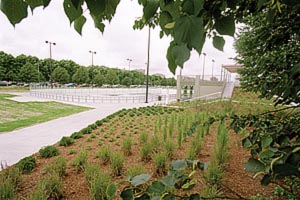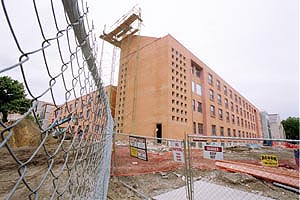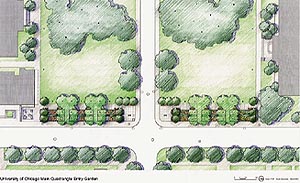Main Quad entryway design draws on work of 1920s landscaper Farrand
By Peter SchulerNews Office
 As the Main Quadrangle awaits landscaping work that will create a gateway to the University, the skating rink and warming house (above) on the Midway Plaisance are now home to a variety of plants and shrubs. Work on the Main Quad landscaping (design at lower right) will begin this summer and be completed in Fall Quarter 2001. The Max Palevsky Residential Commons site (below left) on campus is changing daily as construction crews continue their work there. Ricardo Legorreta, who designed the building, visited campus last month to see the construction progress, which is on schedule. |
In place of the tennis courts that once dominated the east end of the Quad, there will be an open lawn edged with planting beds. A yew hedge, accented by vivid perennial flowers, will border the street from Pick Hall to Eckhart Hall. Flowering trees will frame two pedestrian entrances on both the north and south sides of the driveway.
Landscape architect Alistair McIntosh of Sasaki Associates designed the Quadrangle landscaping plan in consultation with Curt Heuring, University Architect, Richard Bumstead, University Planner, Facilities Services, and a variety of student and faculty groups representing the University community. “We talked with many people around the campus,” Bumstead said. “There was a strong consensus in favor of the open space created by the removal of the tennis courts. We looked at the entrance to the Quad and decided to use plants as our architecture when there was no strong consensus for a wall or other structural options.”
The design draws on the work of Beatrix Jones Farrand, who created campus landscaping in the 1920s. Farrand framed many of the entrances to the Neo-Gothic buildings with plants to make them inviting and easier to locate.
The redesign of the Quad entrance is part of an ongoing landscaping program throughout the campus that includes the planting of annuals and spring bulbs each year. In 1997, the American Association of Botanic Gardens and Arboreta officially recognized the University as a botanic garden. The Facilities Services team worked with the staff of the Morton Arboretum to classify the huge botanical collection and also collaborated on long-term horticultural projects.
 |
“There are a number of aspects that make our situation unique,” Bumstead said. “We are the only botanic garden on the Chicago lakefront, with our own microclimate created by the lake. And we do our planting in a foot of black Illinois topsoil that sits on 13 feet of Lake Michigan sand.” The sand provides an excellent medium for the growth of trees because the roots can spread easily, but is otherwise a poor medium for gardening.
Bumstead explained that each season brings a new round of projects and plantings: bulbs in the spring, annuals in the summer, chrysanthemums in the fall, and Tivoli lights and boughs and branches in the winter. A current priority is to bring color through the use of container plantings to the front doors of buildings like the David and Alfred Smart Museum of Art, Burton-Judson Courts and the School of Social Service Administration. Perennial beds will be expanded to bring more color into dark corners of campus like the north side of Cobb Gate. Flowers with vibrant colors were planted around Bond Chapel to take advantage of the hot midday and afternoon sun.
 |
“The west side of the Administration Building poses particular problems because of the intense afternoon sunlight,” Bumstead noted. Kelly Borak, Lead Horticulturist, Facilities Services, experimented with plant material and containers to find the best fit. She uses heat-tolerant plants that also thrive in dry conditions, and she plants grasses, day lilies, sweet potato vines and purple wave petunias.
“The campus landscaping, along with the redevelopment of the Midway and the berm renovation on 55th Street, are all in sync with a vigorous movement throughout the city to be more aware of the importance of landscaping in our lives,” Bumstead said. Bumstead noted that the Universityís botanic garden is one of only a handful of campus botanic gardens. “I have seen studies showing that visitors to a college campus form a positive or negative impression in the first 15 or 20 minutes after their arrival. Most of what they see here in that time is our landscaping.”
![[Chronicle]](/images/small-header.gif)